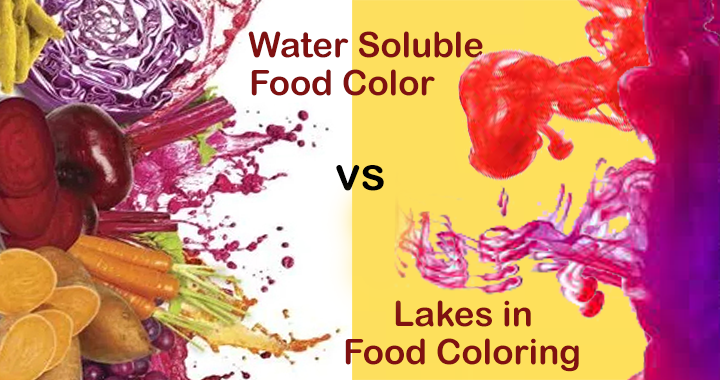Food coloring has become an integral part of the culinary world, elevating the visual appeal of our favourite dishes and beverages. It adds a touch of vibrancy and excitement to a range of culinary creations, from delectable cakes and candies to refreshing beverages and flavourful sauces. Among the various types of food coloring available, water-soluble food colors and lakes are two commonly used options. In this blog, we will delve into the significant differences between these two types of food coloring, exploring their distinct properties and applications.
Water Soluble Food Colors:
Water-soluble food colors, as the name suggests, are colorants that dissolve easily in water. They are typically available in liquid or powder form and are widely used in a variety of food and beverage applications. These colors are made up of water-soluble dyes, which means they can be easily mixed with water-based ingredients without leaving any residue. Water-soluble food colors are known for their vibrant and intense hues, making them ideal for creating eye-catching and visually appealing food products. They are commonly used in products such as beverages, icings, frostings, and other water-based applications.
Lakes:
Unlike water-soluble food colors, lakes are not soluble in water. Lakes are formed by combining water-insoluble dyes with a water-soluble base, usually a metallic salt. This process results in the formation of an insoluble compound that can be dispersed in various mediums such as oils, fats, and waxes. Lakes are often used in applications where water solubility is not required, such as in chocolates, coatings, and oil-based products. They provide a wider range of shades, including more opaque and pastel colors. Lakes are also known for their excellent heat stability, making them suitable for applications that involve high temperatures.
Key Differences:
Solubility: The most significant difference between water-soluble food colors and lakes is their solubility. Water-soluble food colors dissolve easily in water-based mediums, while lakes are insoluble in water and require oil-based or fat-based mediums for dispersion.
Applications: Water-soluble food colors are commonly used in products that require water-based coloring, such as beverages and icings. Lakes, on the other hand, are preferred for applications that involve oils, fats, and waxes, like chocolates and oil-based coatings.
Color Range: Water-soluble food colors offer a wide range of vibrant and intense colors, while lakes provide a broader spectrum of shades, including opaque and pastel colors.
Heat Stability: Lakes exhibit excellent heat stability, making them suitable for applications that involve high temperatures, such as baking and confectionery.
Importance of Water Soluble Food Colors and Lakes in Food Coloring
Enhancing Visual Appeal:
The main purpose of food coloring is to enhance the visual appeal of food and beverages. Water-soluble food colors and lakes offer a wide range of vibrant and intense hues, allowing for the creation of visually stunning culinary creations. These colors can transform a plain-looking dish into an eye-catching masterpiece, enticing consumers and making the dining experience more enjoyable
Versatility in Applications:
Water-soluble food colors are highly versatile and can be easily incorporated into a variety of water-based food and beverage applications. They can be used to color icings, frostings, beverages, and other water-based products. Their ability to dissolve in water ensures even distribution and consistent coloring throughout the mixture.
On the other hand, lakes provide versatility in oil-based applications. They can be used to color chocolates, coatings, oil-based sauces, and other products that require oil or fat as a base. Lakes offer a broader spectrum of shades, including opaque and pastel colors, allowing for more creativity in the kitchen.
Diverse Color Range:
Water-soluble food colors and lakes offer a diverse color range, allowing for endless possibilities in culinary creations. Water-soluble food colors provide vibrant and intense shades, perfect for creating bold and eye-catching presentations. Lakes, on the other hand, offer a wider range of colors, including more opaque and pastel shades, enabling chefs and food manufacturers to experiment with different color palettes and achieve unique visual effects.
Consumer Appeal:
In today’s food industry, consumers are increasingly drawn to visually appealing and aesthetically pleasing food and beverages. The use of water-soluble food colors and lakes allows for the creation of visually stunning products that attract consumers and leave a lasting impression. Bright and vibrant colors can evoke positive emotions and enhance the overall dining experience.
In Conclusion, understanding the differences between water-soluble food colors and lakes is crucial for selecting the most suitable coloring agent for various food and beverage applications. Water-soluble food colors are perfect for water-based products, offering intense and vibrant hues that can elevate the visual appeal of dishes and beverages. Conversely, lakes provide a broader range of shades and exceptional heat stability, making them the preferred choice for oil-based applications. By considering these distinctions, both food enthusiasts and professionals can make informed decisions when choosing the appropriate food coloring, ensuring that their culinary creations achieve the desired visual impact.
